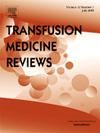Implementation of sexual risk behaviour donor screening in Canada
IF 2.5
2区 医学
Q2 HEMATOLOGY
引用次数: 0
Abstract
Introduction
In 2022 Canadian Blood Services and Héma-Québec removed the three month deferral for men who have sex with men and adopted gender neutral criteria assessing sexual risk behaviours in all donors. We assessed the impact of these changes on the safety and adequacy of the blood supply, one year post-implementation at Canadian Blood Services and 9 months post-implementation at Héma-Québec.
Methods
All allogeneic donors are asked if they have had a new partner or more than one sexual partner in the last 3 months. Donors answering yes to either question are asked if they had anal sex in the last 3 months; if yes, they are deferred for 3 months. We followed HIV rates before and after the criteria change and interviewed HIV positive donors. We assessed the number of donors answering yes to the new questions and the number deferred by age, gender, and donation status. Data on donors, donations, transmissible disease markers and deferrals were extracted from our epidemiology databases. Source plasma donors were not included. Comparisons were made using the chi-square test.
Results
There were three HIV positive donations out of 990,291 donations pre-implementation and four out of 929,384 post-implementation (0.30/100,000 vs 0.43/100,000, P=.72). All post-implementation HIV positive donors were male, Canadian Blood Services' donors in Ontario. One was non-compliant with multiple criteria. No risk factors were identified in the other three positive donors, although one had English comprehension difficulties. 2.9% of donors answered yes to a new partner and/or more than one partner; the percentage answering yes to a new partner was higher than more than one partner (2.6% vs 1.2%, P<.0001). On implementation, 0.15% of donors were deferred for a new partner and/or more than one partner and anal sex. Deferral rates were highest in first time, younger donors, with similar rates in males and females, and have decreased to 0.06% one year post-implementation.
Conclusions
Implementation of sexual risk behavior donor screening resulted in unchanged HIV rates and a manageable impact on blood availability. Gender-neutral criteria have also simplified screening for trans donors. After over 30 years, we are no longer asking donors about their sexual orientation, increasing the inclusiveness in our donor base.
加拿大实施性风险行为捐赠者筛查
导言 2022 年,加拿大血液服务机构和魁北克省血液中心取消了男性同性性行为者推迟三个月献血的规定,并采用性别中立标准评估所有献血者的性危险行为。我们评估了这些变化对加拿大血液服务公司实施一年后和 Héma-Québec 实施 9 个月后血液供应的安全性和充足性的影响。方法询问所有异体捐献者在过去 3 个月中是否有新的性伴侣或一个以上的性伴侣。回答 "是 "或 "否 "的捐献者会被问及在过去 3 个月中是否有过肛交;如果有,则推迟 3 个月。我们跟踪了标准变更前后的 HIV 感染率,并采访了 HIV 阳性的捐献者。我们按年龄、性别和捐献状况评估了对新问题回答 "是 "的捐献者人数和推迟捐献的人数。我们从流行病学数据库中提取了有关捐献者、捐献、传染病标志物和推迟捐献的数据。源血浆捐献者不包括在内。结果实施前的 990,291 例捐献中,有 3 例 HIV 阳性;实施后的 929,384 例捐献中,有 4 例 HIV 阳性(0.30/100,000 vs 0.43/100,000,P=.72)。实施后的所有 HIV 阳性捐献者均为男性,是加拿大血液服务机构在安大略省的捐献者。其中一人不符合多项标准。其他三位呈阳性的献血者中没有发现任何风险因素,但其中一位有英语理解障碍。2.9%的献血者对新伴侣和/或一个以上伴侣的回答是 "是";对新伴侣的回答是 "是 "的比例高于对一个以上伴侣的回答是 "是 "的比例(2.6% vs 1.2%,P< .0001)。在实施过程中,0.15% 的捐献者因有新伴侣和/或不止一个伴侣和肛交而被推迟。首次献血者中,年轻献血者的推迟率最高,男性和女性的推迟率相似,实施一年后,推迟率降至 0.06%。结论实施性危险行为献血者筛查后,艾滋病感染率保持不变,对血液供应的影响可控。性别中立标准也简化了对变性捐献者的筛查。30 多年后,我们不再询问捐献者的性取向,从而提高了捐献者基础的包容性。
本文章由计算机程序翻译,如有差异,请以英文原文为准。
求助全文
约1分钟内获得全文
求助全文
来源期刊

Transfusion Medicine Reviews
医学-血液学
CiteScore
11.60
自引率
0.00%
发文量
40
审稿时长
21 days
期刊介绍:
Transfusion Medicine Reviews provides an international forum in English for the publication of scholarly work devoted to the various sub-disciplines that comprise Transfusion Medicine including hemostasis and thrombosis and cellular therapies. The scope of the journal encompasses basic science, practical aspects, laboratory developments, clinical indications, and adverse effects.
 求助内容:
求助内容: 应助结果提醒方式:
应助结果提醒方式:


